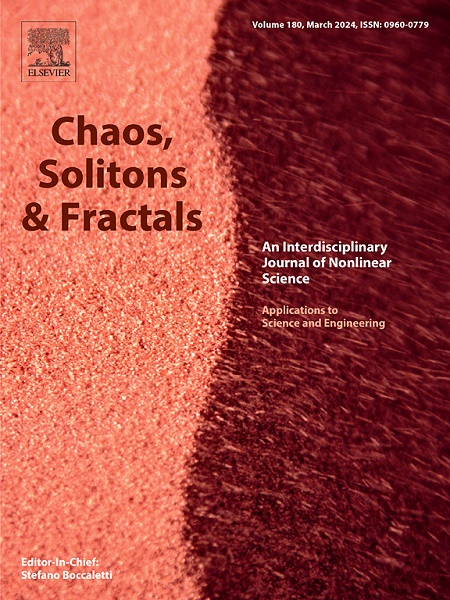分形几何在从遥感影像评估台风强度中的作用
IF 5.6
1区 数学
Q1 MATHEMATICS, INTERDISCIPLINARY APPLICATIONS
引用次数: 0
摘要
台风作为一种典型的湍流系统,在其结构、强度和演化过程中都表现出明显的分形特征。本研究将卫星遥感影像与常规气象观测资料相结合,以台风“海燕”、“威马孙”和“八城”为研究对象。通过分形维数方法的定量分析,探讨台风形态变化、强度演变与分形维数的相关机制。结果表明,台风分形维数的突变往往与强度的快速变化相吻合。具体而言,在强增强阶段,台风外围对小对流区的吸收导致分形维数显著增加。相反,在快速减弱过程中,台风边缘的不规则性增强并向中心靠拢,也导致分形维数上升。这表明分形维数的剧烈变化可以作为台风强度快速变化的指示特征。本研究利用分形维数分析,进一步揭示了台风复杂结构与其强度演变之间的复杂关系,为台风强度预报提供了新的见解和方法途径。本文章由计算机程序翻译,如有差异,请以英文原文为准。
The role of fractal geometry in assessing typhoon intensity from remote sensing images
Typhoons, as a quintessential turbulent system, exhibit marked fractal characteristics in their structure, intensity, and evolutionary processes. This study integrates satellite remote sensing imagery with conventional meteorological observation data, focusing on Typhoons “Haiyan”, “Rammasun”, and “Yagi” as case studies. Through quantitative analysis using the fractal dimension method, it delves into the correlation mechanisms between typhoon morphological changes, intensity evolution, and fractal dimensions. The findings reveal that abrupt changes in the fractal dimension of typhoons often coincide with rapid shifts in intensity. Specifically, during phases of intense strengthening, the absorption of small convective zones by the periphery of the typhoon leads to a significant increase in the fractal dimension. Conversely, during rapid weakening, the irregularity of the typhoon’s edge intensifies and encroaches toward the center, also causing a rise in the fractal dimension. This suggests that drastic changes in the fractal dimension can serve as indicative features of rapid changes in typhoon intensity. By employing fractal dimension analysis, this research advances understanding of the intricate relationship between the complex structure of typhoons and their intensity evolution, offering novel insights and methodological approaches for typhoon intensity forecasting.
求助全文
通过发布文献求助,成功后即可免费获取论文全文。
去求助
来源期刊

Chaos Solitons & Fractals
物理-数学跨学科应用
CiteScore
13.20
自引率
10.30%
发文量
1087
审稿时长
9 months
期刊介绍:
Chaos, Solitons & Fractals strives to establish itself as a premier journal in the interdisciplinary realm of Nonlinear Science, Non-equilibrium, and Complex Phenomena. It welcomes submissions covering a broad spectrum of topics within this field, including dynamics, non-equilibrium processes in physics, chemistry, and geophysics, complex matter and networks, mathematical models, computational biology, applications to quantum and mesoscopic phenomena, fluctuations and random processes, self-organization, and social phenomena.
 求助内容:
求助内容: 应助结果提醒方式:
应助结果提醒方式:


